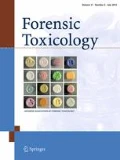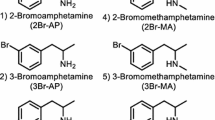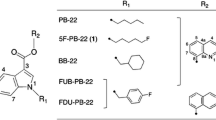Abstract
In recent years, a large number of clandestinely produced controlled-substance analogs (designer drugs) of amphetamine with high structural variety have been detected in forensic samples. Analytical differentiation of regioisomers is a significant issue in forensic drug analysis because, in most cases, legal controls are placed only on one or two of the three isomers. In this study, we used gas chromatography–mass spectrometry (GC–MS) and liquid chromatography–tandem mass spectrometry (LC–MS/MS) for the differentiation of regioisomers of fluoroamphetamine analogs (fluoroamphetamines and fluoromethamphetamines), which were synthesized in our laboratories. Free bases and their acylated and silylated derivatives were subjected to GC–MS analysis using DB-1ms, DB-5ms, and DB-17ms capillary columns. The separation of free bases was incomplete on all columns. Trifluoroacetyl derivatives of 3- and 4-positional isomers showed slight separation on DB-1ms and DB-5ms. On the other hand, trimethylsilyl derivatization enabled baseline separation of six fluoroamphetamine analogs on DB-1ms and DB-5ms columns, which was sufficient for unequivocal identification. For LC–MS/MS, a pentafluorophenyl column was able to separate six regioisomeric fluoroamphetamine analogs but a conventional C18 column could not achieve separation between 3- and 4-positional isomers. These results show that a suitable choice of derivatization and analytical columns allows the differentiation of regioisomeric fluoroamphetamine analogs.












Similar content being viewed by others
References
Namera A, Nakamoto A, Saito T, Nagao M (2011) Colorimetric detection and chromatographic analyses of designer drugs in biological materials: a comprehensive review. Forensic Toxicol 29:1–24
Zaitsu K, Katagi M, Tatsuno M, Sato T, Tsuchihashi H, Suzuki K (2011) Recently abused β-keto derivatives of 3,4-methylenedioxyphenylalkylamines: a review of their metabolisms and toxicological analysis. Forensic Toxicol 29:73–84
Nakajima J, Takahashi M, Seto T, Yoshida M, Kanai C, Suzuki J, Hamano T (2012) Identification and quantification of two new naphthoylindole drugs-of-abuse, (1-(5-hydroxypentyl)-1H-indol-3-yl)(naphthalene-1-yl)methanone (AM-2202) and (1-(4-pentenyl)-1H-indol-3-yl)(naphthalene-1-yl)methanone, with other synthetic cannabinoids in unregulated “herbal” products circulated in the Tokyo area. Forensic Toxicol 30:33–44
Uchiyama N, Kawamura M, Kikura-Hanajiri R, Goda Y (2012) Identification of two new-type synthetic cannabinoids, N-(1-adamantyl)-1-pentyl-1H-indole-3-carboxamide (APICA) and N-(1-adamantyl)-1-pentyl-1H-indazole-3-carboxamide (APINACA), and detection of five synthetic cannabinoids, AM-1220, AM-2233, AM-1241, CB-13(CRA-13), and AM-1248, as designer drugs in illegal products. Forensic Toxicol 30:114–125
Fuller RW, Baker JC, Perry KW, Molloy BB (1975) Comparison of 4-chloro-, 4-bromo- and 4-fluoroamphetamine in rats: drug levels in brain and effects on brain serotonin metabolism. Neuropharmacology 14:739–746
Marona D, Rhee G, Sprague JE, Nichols DE (1995) Psychostimulant-like effects of p-fluoroamphetamine in the rat. Eur J Pharmacol 287:105–113
Nagai F, Nonaka R, Satoh H, Kamimura K (2007) The effects of non-medically used psychoactive drugs on monoamine neurotransmission in rat brain. Eur J Pharmacol 559:132–137
Wee S, Anderson KG, Baumann MH, Rothman RB, Blough BE, Woolverton WL (2005) Relationship between the serotonergic activity and reinforcing effects of a series of amphetamine analogs. J Pharmacol Exp Ther 313:848–854
Europol drugs newsletter (2009) Alert 2009-001, Project SYNERGY, 4-fluoroamphetamine (EDOCF403292)1. http://ewsd.wiv-isp.be/Publicationsonnewpsychoactivesubstances/4-Fluoramphetamine/EuropolDrugsUnit_Newsletter2009-001.pdf
EMCDDA-Europol (2009) Annual report on the implementation of Council Decision 2005/387/JHA. (https://www.europol.europa.eu/sites/default/files/publications/emcdda-europol_annual_report_2009.pdf)
Johansen SS, Hansen TM (2012) Isomers of fluoroamphetamines detected in forensic cases in Denmark. Int J Legal Med 126:541–547
Camilleri A, Johnston MR, Brennan M, Davis S, Caldicott D (2010) Chemical analysis of four capsules containing the controlled substance analogues 4-methylmethcathinone, 2-fluoromethamphetamine, α-phthalimidopropiophenone and N-ethylcathinone. Forensic Sci Int 197:59–66
Seto T, Takahashi M, Nagashima M, Suzuki J, Yasuda I (2005) The identification and the aspects of the commercially available uncontrolled drugs purchased between Apr. 2003 and Mar. 2004. Ann Rep Tokyo Metr Inst P H 56:75–80 (in Japanese)
Nagashima M, Seto T, Takahashi M, Suzuki J, Yasuda I (2006) Spectrum data of the 3rd governor-designated drugs and the analyses of uncontrolled drugs purchased Apr. 2005–Mar. 2006. Ann Rep Tokyo Metr Inst P H 57:109–113 (in Japanese)
Uchiyama N, Kikura-Hanajiri R, Kawahara N, Goda Y (2008) Analysis of designer drugs detected in the products purchased in fiscal year 2006. Yakugaku Zasshi 128:1499–1505 (in Japanese)
Uchiyama N, Miyazawa N, Kawamura M, Kikura-Hanajiri R, Goda Y (2010) Analysis of newly distributed designer drugs detected in the products purchased in fiscal year 2008. Yakugaku Zasshi 130:263–270 (in Japanese)
Yii-Kauhaluoma J, Vahermo M, Suominen T, Leinonen A (2009) Synthesis and characterization of hydroxylated mesocarb metabolites for doping control. Arch Pharm Life Sci 342:201–209
Shulgin AT, Shulgin A (1991) PIHKAL: a chemical love story. Transform Press, Berkeley
Rösner P, Quednow B, Girreser U, Junge T (2005) Isomeric fluoro-methoxy-phenylalkylamines: a new series of controlled-substance analogues (designer drugs). Forensic Sci Int 148:143–156
Westphal F, Rösner P, Junge Th (2010) Differentiation of regioisomeric ring-substituted fluorophenethylamines with product ion spectrometry. Forensic Sci Int 194:53–59
Acknowledgments
This work was supported in part by the R&D Program for Implementation of Anti-Crime and Anti-Terrorism Technologies for a Safe and Secure Society, Strategic Funds for the Promotion of Science and Technology of the Ministry of Education, Culture, Sports, Science, and Technology of Japan.
Conflict of interest
There are no financial or other relations that could lead to a conflict of interest.
Author information
Authors and Affiliations
Corresponding author
Rights and permissions
About this article
Cite this article
Nakazono, Y., Tsujikawa, K., Kuwayama, K. et al. Differentiation of regioisomeric fluoroamphetamine analogs by gas chromatography–mass spectrometry and liquid chromatography–tandem mass spectrometry. Forensic Toxicol 31, 241–250 (2013). https://doi.org/10.1007/s11419-013-0184-7
Received:
Accepted:
Published:
Issue Date:
DOI: https://doi.org/10.1007/s11419-013-0184-7




